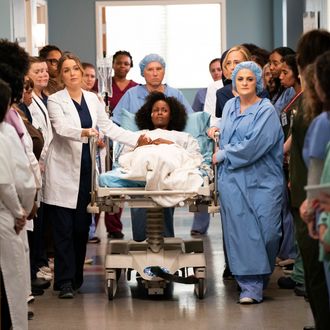
In March, Shondaland delivered one of the most emotionally charged episodes of Grey’s Anatomy to date. Season 15’s 19th episode “Silent All These Years” tackled consent and rape through the biological discovery of Jo (Camilla Luddington) and the assault of her patient Abby (Khalilah Joi). In a conversation at a WGA screening series in Los Angeles Tuesday night, Grey’s showrunner Krista Vernoff and episode writer Elisabeth R. Finch reflected on how the episode, and that instantly iconic hallway filled with the “Army of Awesome,” was born.
The episode pushed many boundaries, from delving into the emotional trauma of rape from a female perspective to showing a rape kit being administered in the hospital. Over the course of the hour, Abby must go through a devastating process after being assaulted and Jo learns that she herself was a product of rape, which is why her mother gave her up. One of the standout moments is the “hallway” scene, in which the female employees of the hospital line the halls, giving Abby the strength to move past the image of her attacker and on to the surgery she needs.
Finch recalled the very first image of the episode she saw in her head before putting pen to paper. She described vivid memories of her time at the Rape Treatment Center at UCLA a few years prior to penning the episode.
“[It] is the gold standard for how they treat victims of rape and sexual assault and they toured us through as if we were a patient, who would be walked through every single room,” the writer explained. “What I was really struck by between every room that we went there was a radio community among all the staff that let us know from room to room, when we could move and make sure that a patient wasn’t moving, or walking down the hallway,” she continued. “They say it was because that patient needed to not see anyone’s face, that they shouldn’t need to come out to a stranger. They treat every patient that walks through their doors as an individual and based on what they need in those moments, which I found fascinating.” Finch explained she actually imagined the opposite: walls filled with women protecting and looking over victims. And there was the Army of Awesome.
If viewers look closely, the actual Army of Awesome was actually made up of very few actors. Krista Vernoff explained that after the “sacred” table read, crew members wanted so badly to be part of the scene, they offered to do it without pay. “Pretty much everyone, every woman in the room came up to us and said, ‘I want to be in that scene … I’m willing to lose a day’s pay, can I just be in the scene?’” the showrunner recalled. “Because we are lucky to work at Shondaland, we made it possible for everyone who wanted to be in the scene to be in the scene without losing any pay,” she continued. “We paid people to come and cover them. And so the scene is: our writers, the PAs, the assistants, the crew, the line producers. All the women who work at Shondaland. It was amazing.”
As the two have previously discussed in interviews, the episode was inspired by the hearings of Dr. Christine Blasey Ford and Brett Kavanaugh last September when Ford accused the then-Supreme Court nominee of assault. “Our collective blood was boiling,” Vernoff said. “We have to do something about consent, because all of the kids in the country have now been taught that consent is irrelevant. We have an opportunity to refute the notion that consent doesn’t matter.” Finch also added that she spoke with real survivors, and got input from crew members about their loved ones’ experiences, while writing the episode.
As Vernoff puts it, it is a socially responsible yet “riveting hour” of TV. “I can’t breathe. I’m on the edge of my seat. I’ve seen it 155 times. I watch it, I cry every time … And it has an impact,” she said. “I am tired of awarding shows that use dead, raped female corpses as props for the male cops to go do their job … And if I can’t turn on the TV and find it. I’m going to keep making it.”

